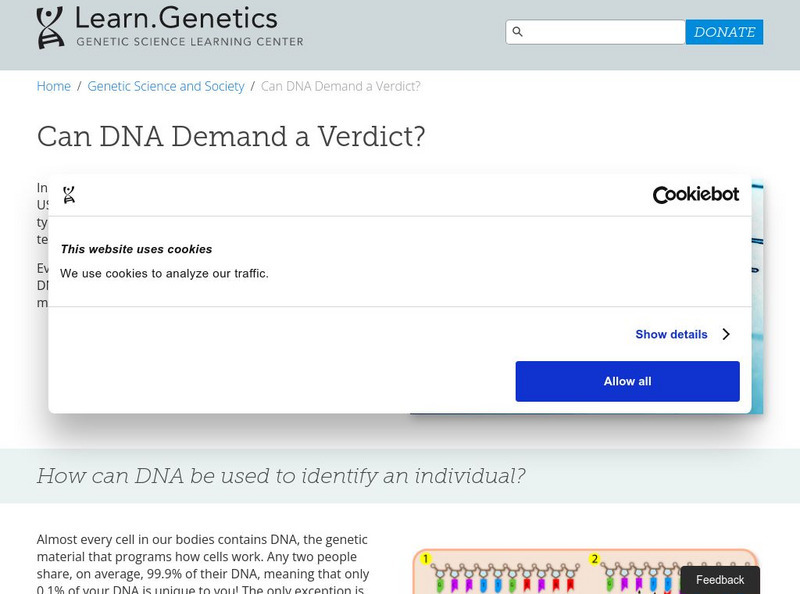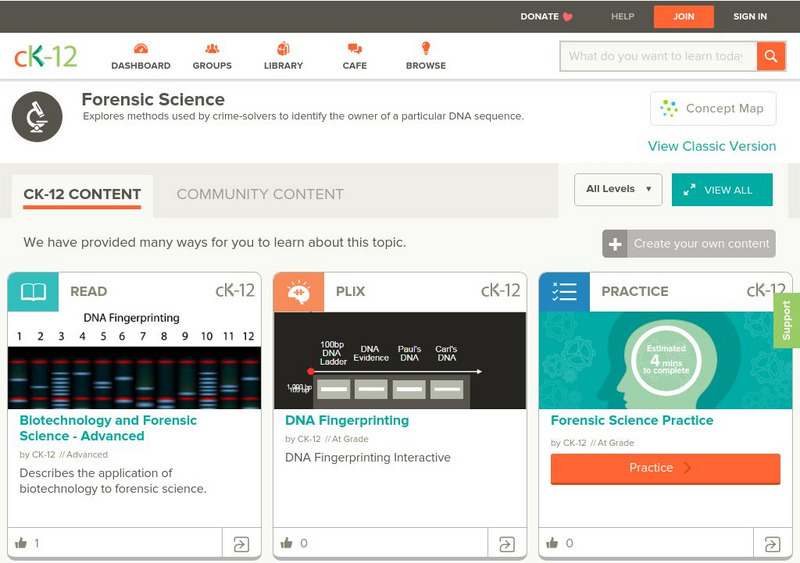Curated OER
Investigating the Uses of Backyard Bacteria
High schoolers discover that the answers to some of society's waste and clean-up problems may be no further than the soil beneath their feet. They perform a Gram stain on the colonies to determine some of their characteristics.
Curated OER
Dig Magazine Archeology Quiz #106
In this Dig Magazine archeology quiz, students answer 12 multiple choice questions complementing the October 2009 issue. Page contains answer and additional resources link.
PBS
Pbs Learning Media: Forensic Dna Analysis
This video segment from NOVA: "The Killer's Trail" investigates the potential for DNA evidence to solve murder cases, even those from the distant past.
University of Utah
University of Utah: Genetic Science Learning Center: Dna and Verdicts
Part of a site on genetics, this page explores DNA as a forensic science. Explains how and why DNA can be used to convict or acquit a criminal from wrongdoing using forensic DNA analysis. Teacher resources too.
PBS
Pbs Learning Media: Forensics and Dna Profiling
Find out how DNA profilers analyze bits of tissue to identify human remains. From the NOVA: "Lost on Everest" Web site.
PBS
Pbs Learning Media: How Dna Evidence Works
In this article by An Meeker-O'Connell, discover how DNA evidence is processed before it goes to court.
PBS
Pbs Learning Media: Dna Fingerprint Photos
These photographs supplied by Genelex Corporation depict actual DNA fingerprints and show the types of information that can be gleaned from them.
Oak Ridge National Laboratory
Oak Ridge National Laboratory: Dna Forensics
A concise explanation of the use of DNA technologies in forensic identification from the Oak Ridge National Laboratory. Additional valuable resources are provided.
Georgia Department of Education
Ga Virtual Learning: Forensic Science: Dna Analysis
How is DNA evidence analyzed? What makes DNA evidence unique? This comprehensive interactive tutorial explores how old or degraded samples can be analyzed for DNA as well as how DNA profiles are stored.
Science Buddies
Science Buddies: Forensic Science: Building Your Own Tool for Identifying Dna
When biologists want to separate different pieces of DNA, RNA, or proteins they use a technique called gel electrophoresis. In this science project you'll build a gel electrophoresis chamber and use it to discover how many components are...
Science Buddies
Science Buddies: Who Done It? Dna Fingerprinting and Forensics
DNA fingerprinting (also known as DNA profile analysis and DNA typing), is a method of distinguishing between individuals by analyzing patterns in their DNA. This project focuses on the first method of DNA fingerprinting to be developed,...
PBS
Nova: Identifying Remains With Dna
Mitochondrial DNA has different properties than nuclear DNA which make it beneficial in certain forensic settings. Get the details on the ways mitochondrial DNA is being used in forensic science.
Cold Spring Harbor Laboratory
Dna Interactive: Applications
Examples of using DNA for forensic purposes is discussed here, as well as uses to unravel historical puzzles, trace the history of a species and answer health problems.
National Health Museum
Access Excellence: Dna Detectives
A hands-on activity from Access Excellence for advanced biology classes. Students are given a crime scenario and three suspects. Their mission is to determine 'Who Dunnit?' by obtaining and analyzing DNA samples. Requires extensive...
TeachEngineering
Teach Engineering: Dna Forensics and Color Pigments
Students perform DNA forensics using food coloring to enhance their understanding of DNA fingerprinting, restriction enzymes, genotyping and DNA gel electrophoresis. They place small drops of different food coloring ("water-based paint")...
Columbia University
Columbia University: Dna as a Forensic University
Good article on the power and use of DNA evidence in court cases.
PBS
Pbs Learning Media: Dna on the Witness Stand
Dr. Eric Lander of the Human Genome Project explains the use of DNA as forensic evidence. He describes the process and need for standards in testing laboratories and discusses the use of DNA evidence as a human rights tool.
CK-12 Foundation
Ck 12: Biotechnology and Forensic Science
[Free Registration/Login may be required to access all resource tools.] Read this complete, illustrated article which gives a detailed look at the role genetics plays in forensic science.
BiologyWise
Biology Wise: History of Dna Fingerprinting
Discusses the scientists who made discoveries about DNA and those who invented and worked on DNA fingerprinting, and some of the criminal cases that were resolved or thrown out through the use of DNA evidence. (Warning: Some of these...
National Institutes of Health
National Library of Medicine: Key Accomplishments, Dna
A brief history of the major discoveries related to DNA from 1865 until 1991. Pictures of the responsible reponsibile for these key accomplishments are included as well.
National Institutes of Health
National Library of Medicine: Dna a Molecular Identity
In this lesson plan site, students learn about DNA and examine three different situations where DNA was used to solve a case.
BiologyWise
Biology Wise: Why Is Dna Important
Explains what DNA is and how much information lies stored in its structure, and discusses the many applications of the science of DNA in agriculture, forensic science, human genetics, etc.
University of Arizona
The Biology Project: Human Biology: Dna Forensics Problem Set 2
Students practice a problem using DNA profile analysis to characterize human DNA samples as applied in paternity analysis and sex crimes investigations.
University of Arizona
The Biology Project: Human Biology: Dna Forensics Problem Set 1
Students have the opportunity to interpret actual case results from the use of the Restriction Fragment Length Polymorphism (RFLP) method to characterize human DNA samples as applied in paternity analysis and sex crimes investigations.














